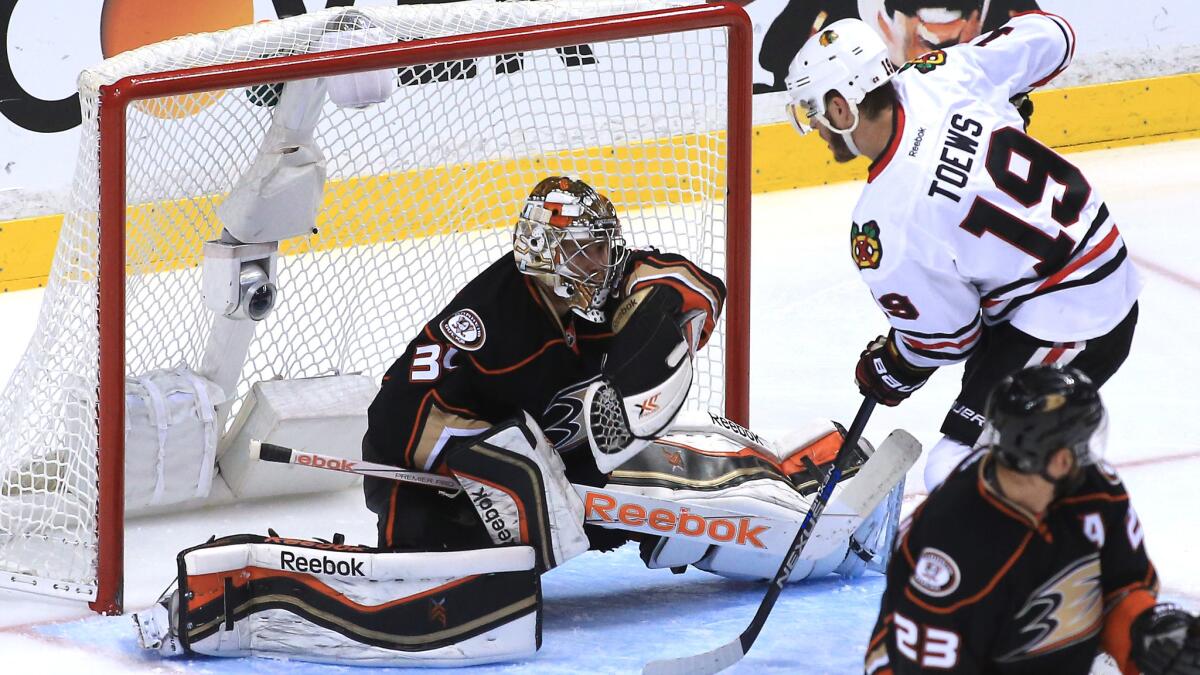Ducks’ Frederik Andersen is a cool customer, even in defeat

- Share via
The water that runs through the veins of Ducks goaltender Frederik Andersen stayed colder than the stuff that was chilled to make the all-too-slushy ice surface of the Honda Center on Tuesday. If he ever flinches it’s not while he’s wearing his mask and pads and other gear, so stoic and calm is the red-haired Dane while facing the NHL’s best shooters and most pressure-packed situations.
Twice he came up with superb saves in sudden-death play to prolong Game 2 of the Ducks’ Western Conference final series against the Chicago Blackhawks, once in overtime and again in double overtime, the calmest person in the din of a sellout crowd at a rocking arena.
Finally, though, Andersen couldn’t stop Chicago forward Marcus Kruger’s deflection of a shot by Brent Seabrook in triple overtime, and the Blackhawks gutted out a 3-2 victory that gave them a split of the first two games. The series will resume Thursday at the United Center; by then, Andersen should have recovered from his 53-save performance and Chicago goalie Corey Crawford from the rigors of his stellar 60-save effort.
“It was just a tough loss,” Andersen said after taking some time to replace the fluids he had lost through sweat and exertion. “I think we had some really good chances and it was a tough pill to swallow. We’ve got to get on with it, on Thursday....
“We’ve got to have a short memory right now....Nothing you can do about it now.”
Not even when Chicago’s Andrew Shaw headed the puck into the net soccer-style eight minutes and 47 seconds into the second overtime and the Blackhawks poured off their bench in apparent glee did Andersen show the smallest flicker of concern. As he expected, the goal was disallowed and the teams went to a third sudden-death period, continuing a display of the kind of gutsy, gritty hockey that makes the NHL playoffs so compelling.
“You’ve just got to keep thinking about the next shot, the next shot,” he said of maintaining his concentration. “Nothing really more to it.”
Andersen used his head the right way, though Shaw deserved points for creatively using his head.
“We really didn’t have the best first period but after that, I just feel, keep doing what I do and make the saves for them to come back,” said Andersen, who added that he felt fine after his long night’s work. “We did a good job of scoring. We just couldn’t get the third one in. Hit the post a couple of times, some bad bounces. That’s how it goes.”
In the Ducks’ first multiple-overtime game since the second game of their second-round series against Detroit on May 3, 2009, Andersen was their rock, a performance matched at the other end of the ice by Crawford, who got help from his goal posts on shots by Ryan Getzlaf, Corey Perry and Sami Vatanen.
Still, some help from the pipes didn’t make for an easy night for Crawford. When told after the win he just played in the longest game in Blackhawks history he said, “It felt like it.”
Andersen seemed to make the more dramatic saves. Late in the first sudden-death period he was part of a classic confrontation: Prolific Blackhawks winger Patrick Kane was dashing up the right side after a turnover by the Ducks had left nothing but open ice between him and Andersen. The puck and the game were on Kane’s stick, giving him a chance to dramatically change the momentum of the series in a split second.
With Ducks defenseman Francois Beauchemin coming toward him late, Kane took a shot from the circle. Andersen reached up with his glove and swiftly snared the puck, calm as ever, while crowd roared its approval.
In the first two minutes of the second sudden-death session, Andersen had to make a point-blank stop on Shaw; later, while his teammates visibly flagged, he held them up and helped kill a penalty that had been called against them for too many men on the ice.
And to think there was some doubt whether Andersen would even be the Ducks’ starting goaltender before the playoffs began. Coach Bruce Boudreau was leaning that way, and correctly so, but he and the organization are infatuated with the talent of young John Gibson and Boudreau might have been tempted to go with Gibson. But Gibson’s late-season illness took the decision out of Boudreau’s hands, cementing Andersen’s status as the starter and giving the Ducks a commanding presence in net.
They needed every bit of his poise. Early in the game they dredged up a reminder of the bad, old habits that contributed to their early playoff exits the past few seasons and took some needless penalties, letting their emotions get the better of them.
Those shortcomings cost them in the form of two power-play goals by the Blackhawks, the first playoff game this spring in which the Ducks had given up more than one power-play goal. Those shortcomings cost them in the form of two power-play goals by the Blackhawks, the first playoff game this spring in which the Ducks had given up more than one power-play goal.
Seeing that ugly flashback served as a reminder of how badly they used to sabotage themselves — and how far they’ve distanced themselves from the team that ended its season with first- or second-round playoff exits and regrets, not championships. Andersen has done his part by keeping his head while others were butting theirs.
helene.elliott@latimes.com
Twitter: @helenenothelen
More to Read
Go beyond the scoreboard
Get the latest on L.A.'s teams in the daily Sports Report newsletter.
You may occasionally receive promotional content from the Los Angeles Times.






